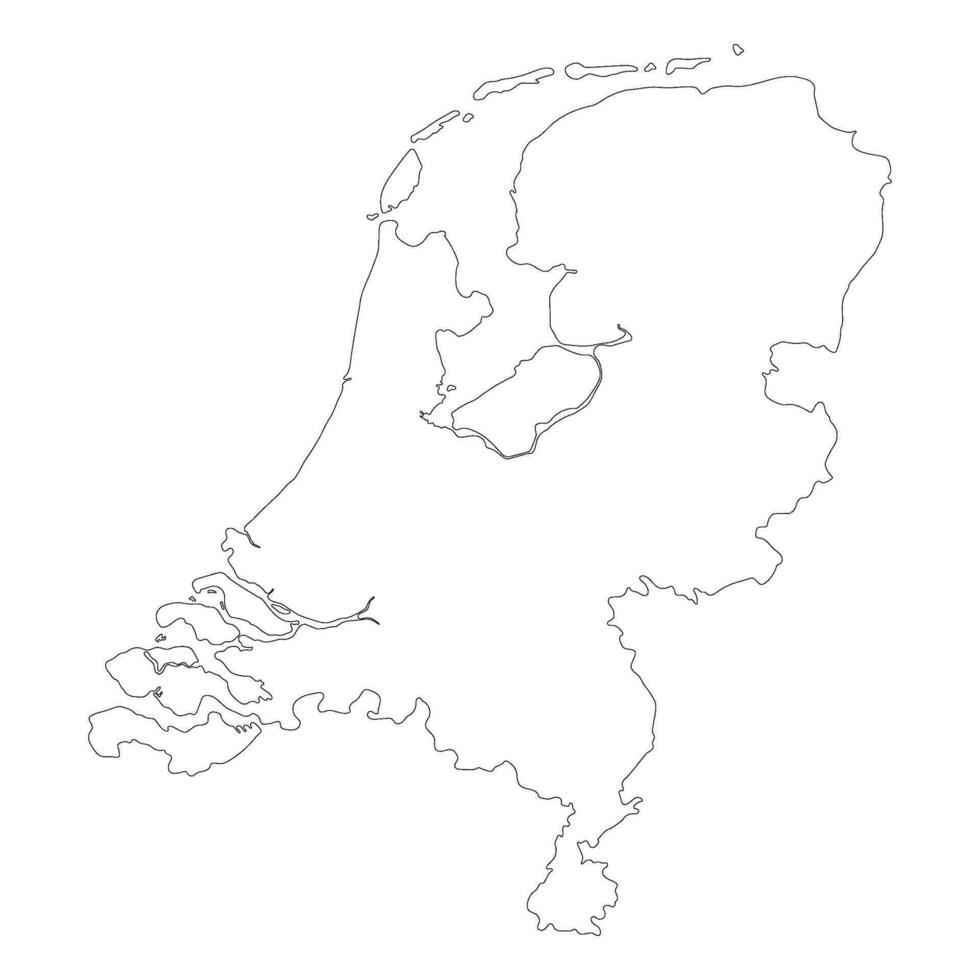🚧 Excuses!
Deze pagina is nog niet volledig vertaald. Wel is er een complete versie in het Engels.
Overzicht
Inhoud:
Locatie
De projectlocatie bevindt zich in de geplande wijk 'Sluisbuurt' in Amsterdam. Aan het oostelijke uiteinde van de haven van de stad bouwt Amsterdam talloze kunstmatige eilanden om de woningcrisis te bestrijden. Dit gebied wordt gebruikt voor veel innovatie en experimenten in moderne residentiële architectuur. Sluisbuurt ligt aan het noordwestelijke uiteinde van Zeeburgereiland, met uitzicht op de Oosterdokeilanden aan de overkant van het water. De wijk is momenteel niet gebouwd, maar wordt omringd door andere nieuwe wijken.
Ontwerpopgave
Deze fictieve opdracht was onderdeel van mijn bacheloropleiding. Het idee was dat iedereen individueel aan één perceel/gebouw zou werken, maar dat we als groep één samenhangende buurt zouden creëren, zodat we de overlap tussen architectuur en stedenbouw zouden ervaren. Dit omvatte ook het ontwerpen van openbare ruimtes. Het doel was om het begrip 'wonen' te onderzoeken, ermee te experimenteren, en te begrijpen wat dat echt betekent en wat er nodig is om dit mogelijk te maken. Daarnaast moesten de gebouwen een hoge woondichtheid met gemeenschappelijke en/of openbare functies bieden en duurzaam zijn.
Functies van Wonen
Wat betekent het om te leven? Wat heeft men echt nodig en wat wil iemand in zijn woning hebben? Hoe moeten ontwerpers deze vragen beantwoorden en welke rol zouden ze hierin moeten spelen? Deze en nog veel meer vragen werden ons voorgelegd om over na te denken in deze studio. Als reactie hierop was de eerste stap die ik zette in het onderzoek- en ontwerpproces het inventariseren van verschillende acties, functies, meubels, faciliteiten, etc. die iemand in zijn woning zou gebruiken. Ik deed twee inventarissen: één op basis van de 'kamers' waarin men doorgaans bepaalde faciliteiten zou vinden en bepaalde acties zou uitvoeren, en een andere op basis van de volgorde waarin men een routine zou doorlopen (bijv. 's ochtends wakker worden om zich klaar te maken voor werk). Vervolgens verbond ik de losse wolk van woorden met elkaar en groepeerde ze op bruikbaarheid, gebruik en routine, om inzicht te krijgen in welke acties en objecten meer naast elkaar zouden moeten liggen en welke meer zouden fungeren als kruispunten langs meerdere 'routes' over de mindmap. Vanuit deze analyse begon ik 'plattegronden' te maken waarin functies werden geclusterd om gedefinieerde zones te creëren. Deze hele oefening gaf inzicht en begrip in de relaties tussen verschillende functies en daagde mijn begrip uit van typische indelingen van ruimtes en functies. De inzichten die uit deze analyse voortvloeiden, waren cruciaal voor de ontwikkeling van het projectconcept.
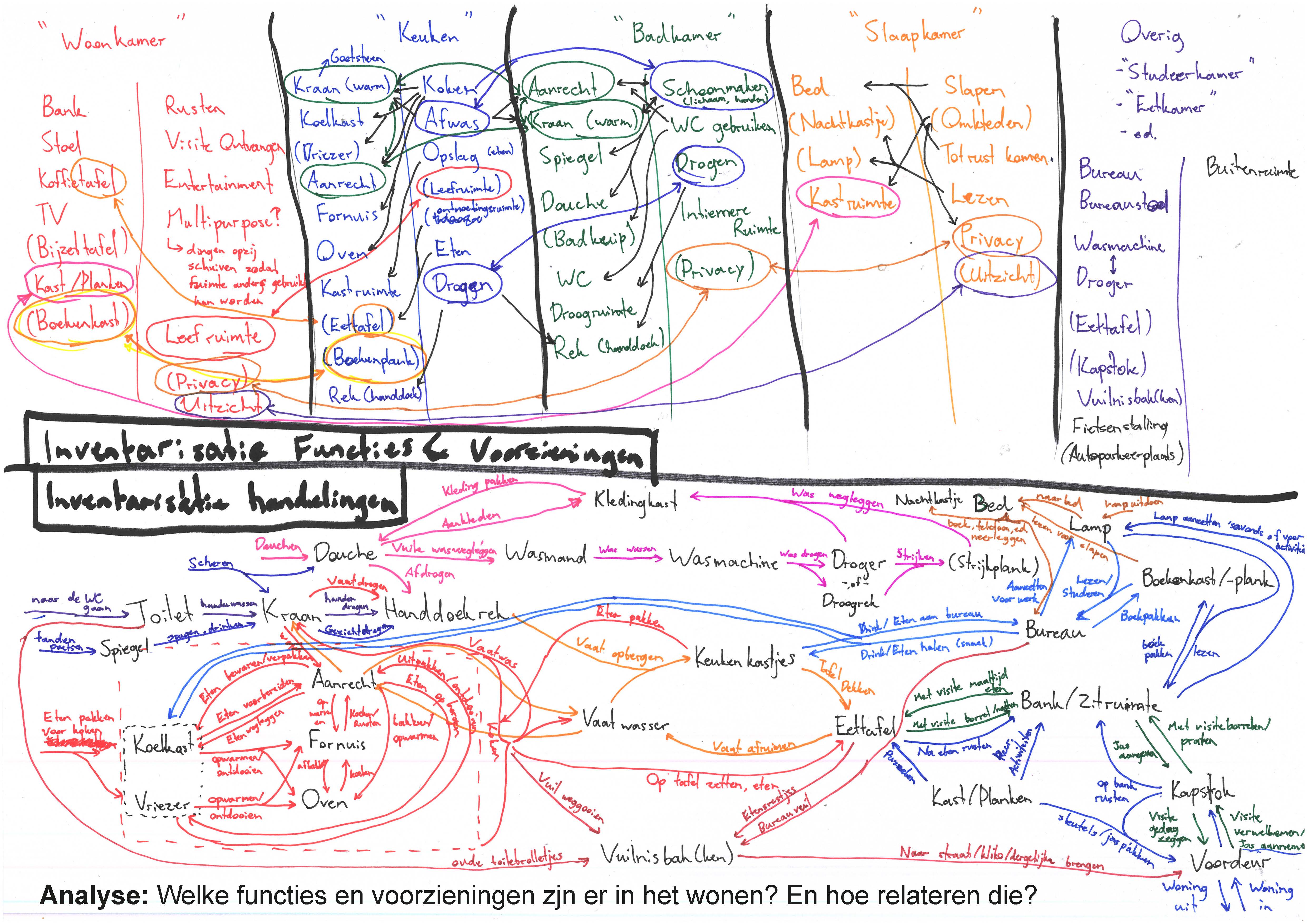
Analyse van verschillende functies, hoe ze met elkaar zouden verbinden (onder) en waar ze traditioneel te vinden zijn (boven)

Analyse van verschillende functies, hoe ze met elkaar zouden verbinden (onder) en waar ze traditioneel te vinden zijn (boven)
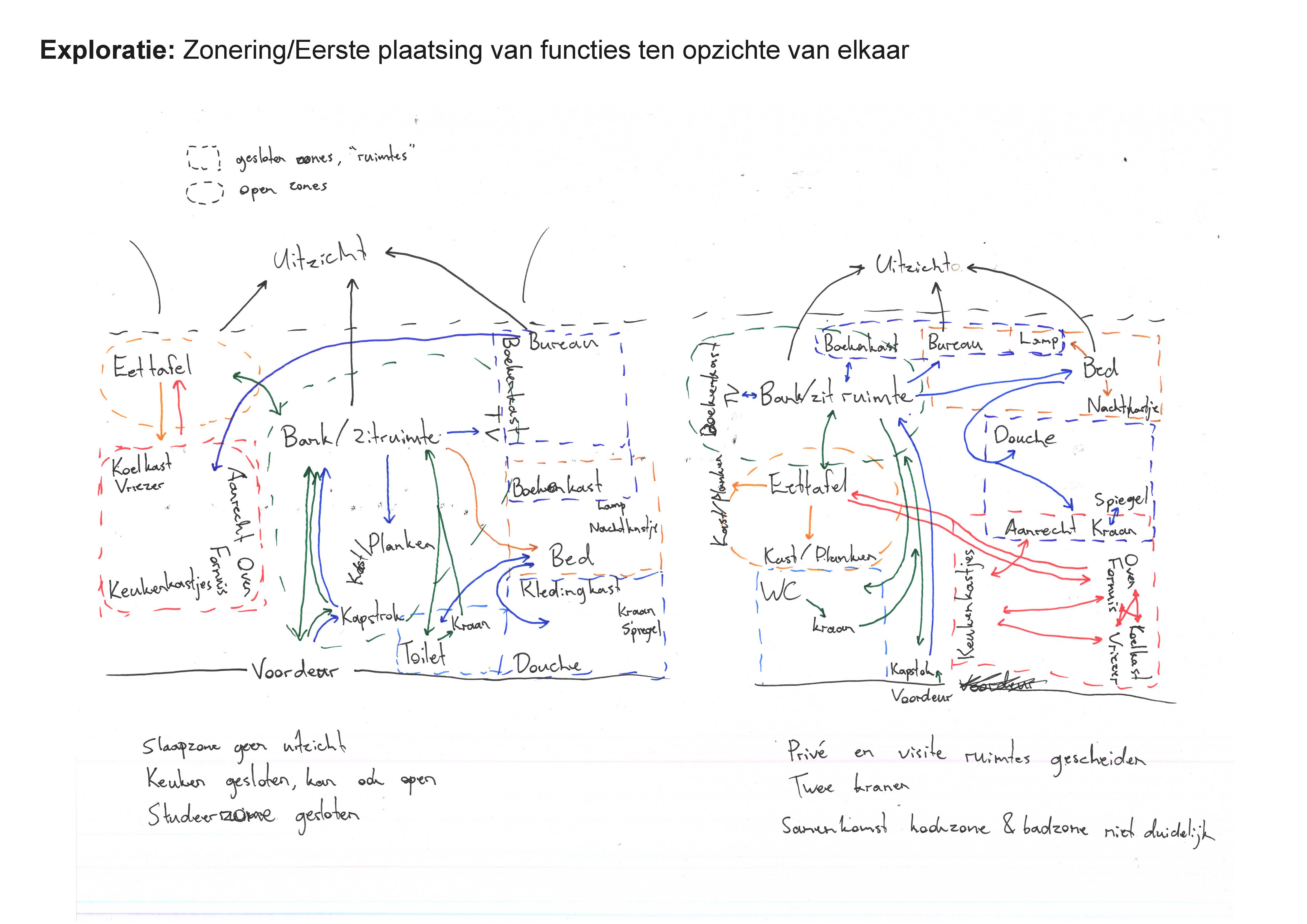
Pogingen om functies te organiseren rondom elkaar, in plaats van individuele 'kamers'

Pogingen om functies te organiseren rondom elkaar, in plaats van individuele 'kamers'
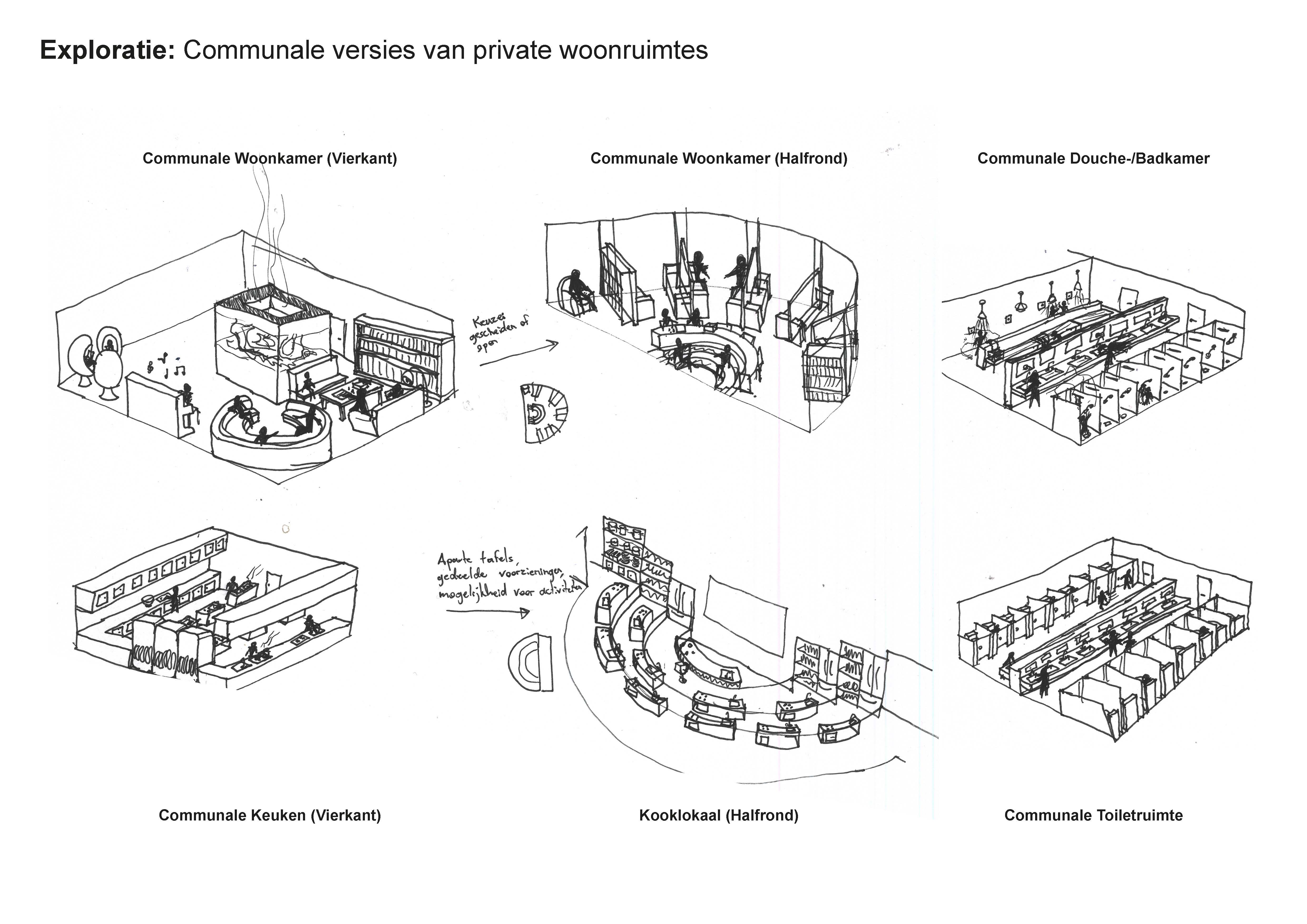
Experiment om te zien hoe ruimtes eruit zouden zien als traditionele 'kamers' een gemeenschappelijke voorziening zouden zijn buiten de individuele woning

Experiment om te zien hoe ruimtes eruit zouden zien als traditionele 'kamers' een gemeenschappelijke voorziening zouden zijn buiten de individuele woning
Naast de vorige twee analyses werd een derde analyse uitgevoerd om te experimenteren met het concept van co-living en collectieve ruimtes. Er is al veel werk verricht met betrekking tot gemeenschappelijke voorzieningen en ruimtes, maar ik wilde zien wat er zou gebeuren als traditioneel geïndividualiseerde ruimtes collectief zouden worden gemaakt, buiten de privéwoning. Om te zien hoe zulke ruimtes eruit zouden zien en hoe ze zouden functioneren, schetste ik enkele concepten in de derde afbeelding hierboven. Ik probeerde te zien hoe een keuken, woonkamer en badkamer eruit zouden zien als ze gedeeld zouden worden door een heel appartementengebouw, waarvan de resultaten hierboven te zien zijn.
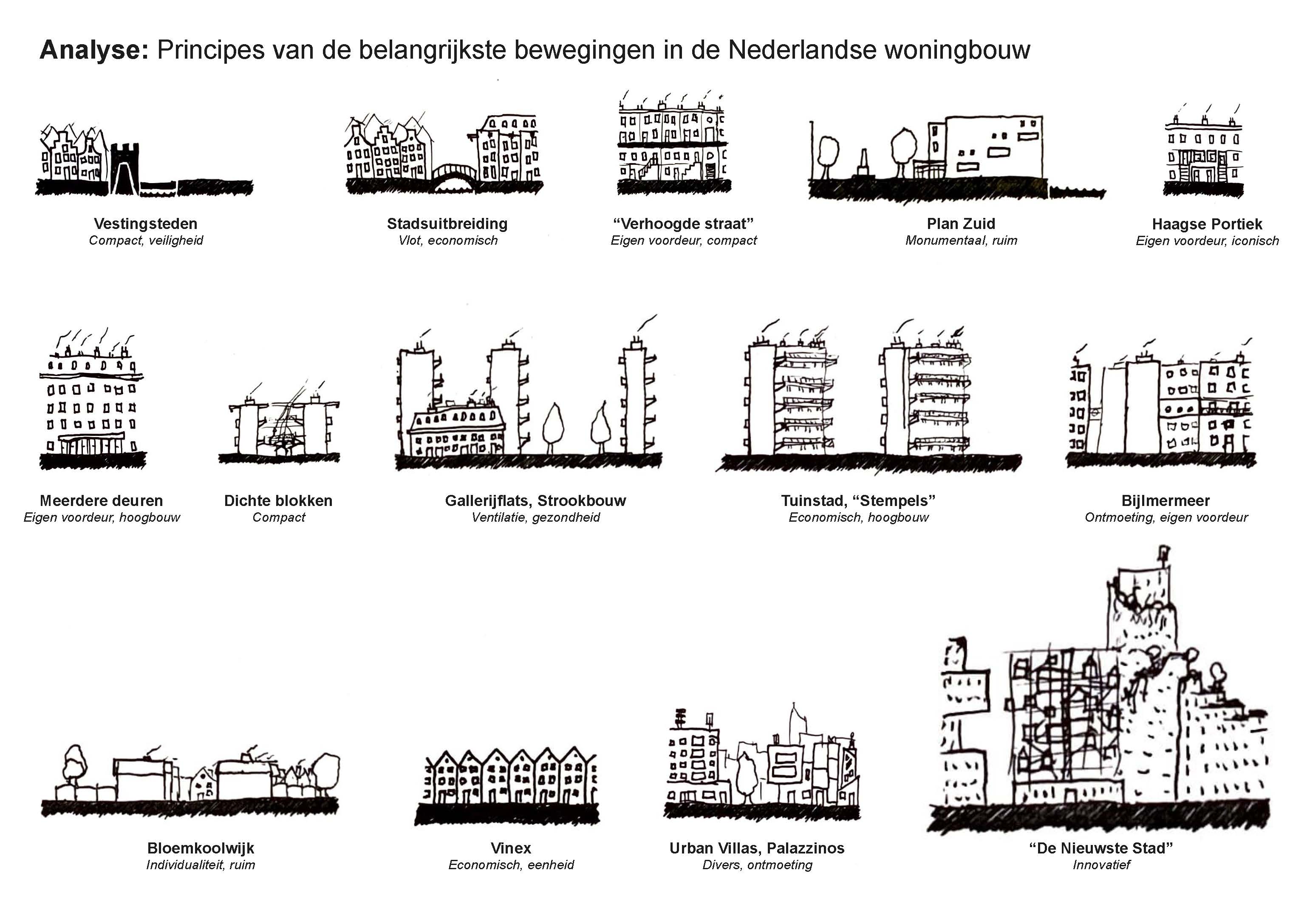
Geschiedenis van ontwikkelingen in de Nederlandse Woningbouw en hun idealen

Analyse van verschillende ontwikkelingen in de geschiedenis van de Nederlandse Woningbouw en de belangrijkste aspecten achter hun filosofie
Geschiedenis van Nederlandse Woningbouw
The first step I took in the design process for this project was to research the outcomes and goals of historic housing movements. The image to the rightabove is a summary I made based on the lecture given by our dean, Dick van Gameren. During the lecture, the history of Dutch housing was discussed at length, describing major movements, the reasons they came to be and developed into what they were, as well as their successes and failures, and how, ultimately, new movements arose to respond. In the summary I produced, one can see the rough architectural expression it invokes, as well as the ideals that were held in their development. Each period and plan is hailed for bringing new ideas to the table, through innovation or the revival and re-appreciation of old ideas. By looking at each period I was able to make a list of ideals which would serve as a starting point for the main concept of my design. This list and the eventual concept can be found below.
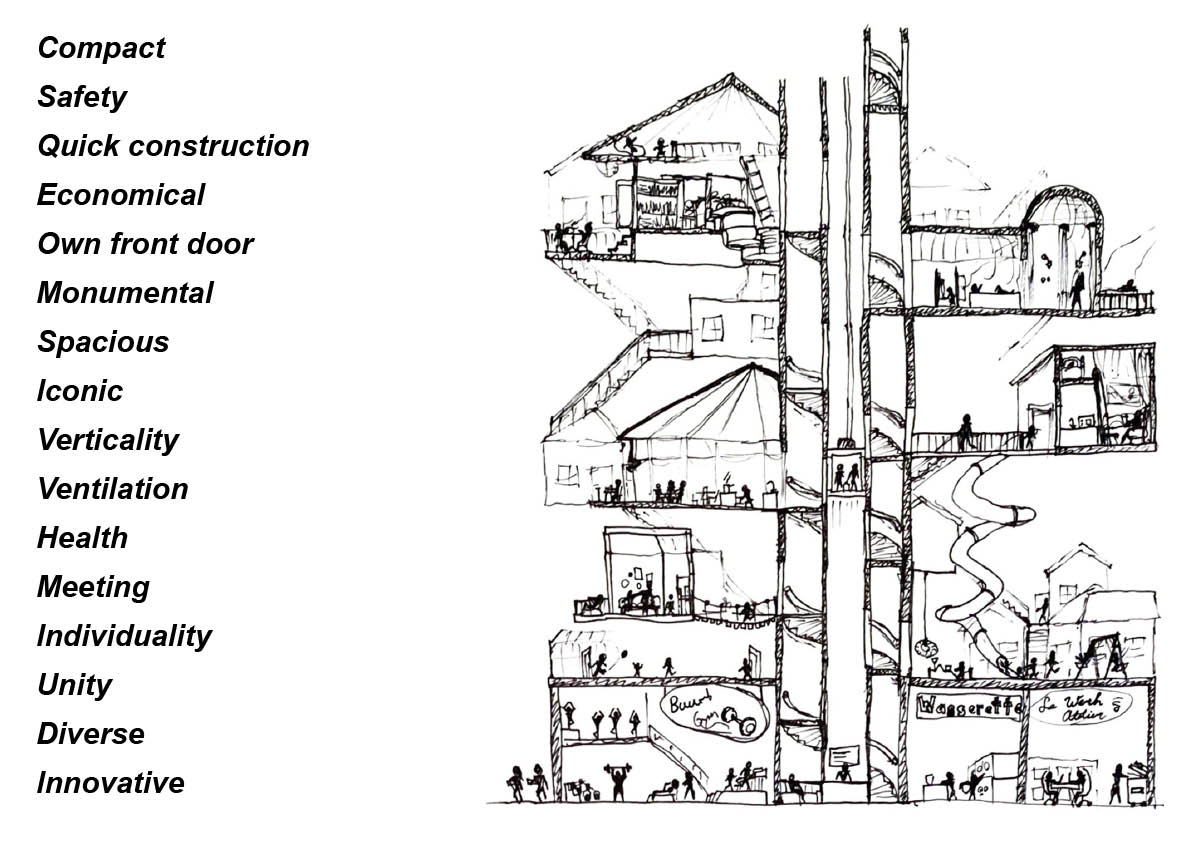
First concept sketch and primary goals

Drawing summarizing the main concept of the design
Blending Living and Leisure
Based on the research I did, and the scope of the assignment, I decided the main focus of the building should be about having playful and enjoyable elements to justify higher densities. By having communal functions, a creating monumental and fun experience, living more compact becomes more appealing. In addition, my personal stance toward housing architecture is that it often lacks a principle or concept which make it more appealing to the user, and less so the investor. This design course provided an excellent opportunity to experiment with such a concept.
It takes a (vertical) village
One of the issues often found with densified and urban living conditions is high anonymity and a lack of community. As such, one of the principles I wanted to integrate in the building was a sense of neighborliness, a strong identity for the community to live in, a safe place for everyone to interact with each other. The inspiration taken for applying this principle is that of a village; having a defined, individual space which can be personalized to express oneself, and a communal space where one can meet in comfort creates a much stronger sense of belonging necessary for successful community-building.
Main Concepts
As described above, the main idea for the building is to create a fun and dynamic building, with plenty of communal spaces and facilities to encourage neighborly interaction. This occurs at two levels: within the building, and within the larger neighborhood. The city of Amsterdam has envisioned the Sluisbuurt area to be a mixed-use area, primarily focussed on leisure and targeted towards the middle and upper segments and towards family households. As such, I wanted to focus on giving families a strong sense of an individual space, within a greater communal whole. The first diagram below shows how individual units exist as unique objects bound together to create dynamic spaces around a central core/hub where most interaction takes place. An additional concept that was considered was variation: not all households are the same, so to impose a one-size-fits-all model is inappropriate here. In the second diagram, it can be seen that the individual 'houses' can be variated upon for individual expression, up- and downsizing.
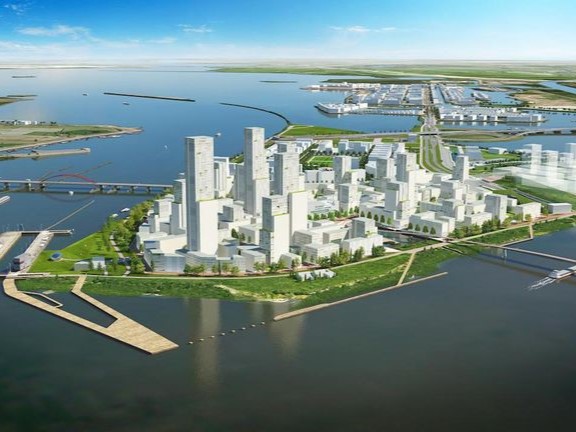
Vision for the development of Sluisbuurt

Vision for the development of Sluisbuurt
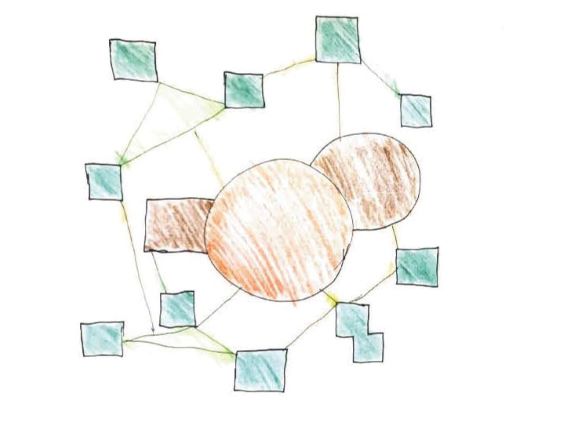
Diagram of the arrangement of public and private spaces through volumes

Diagram of the arrangement of public and private spaces through volumes

Diagram fo the expandable concept of the modular unit-based design

Diagram fo the expandable concept of the modular unit-based design
Plans & Sections
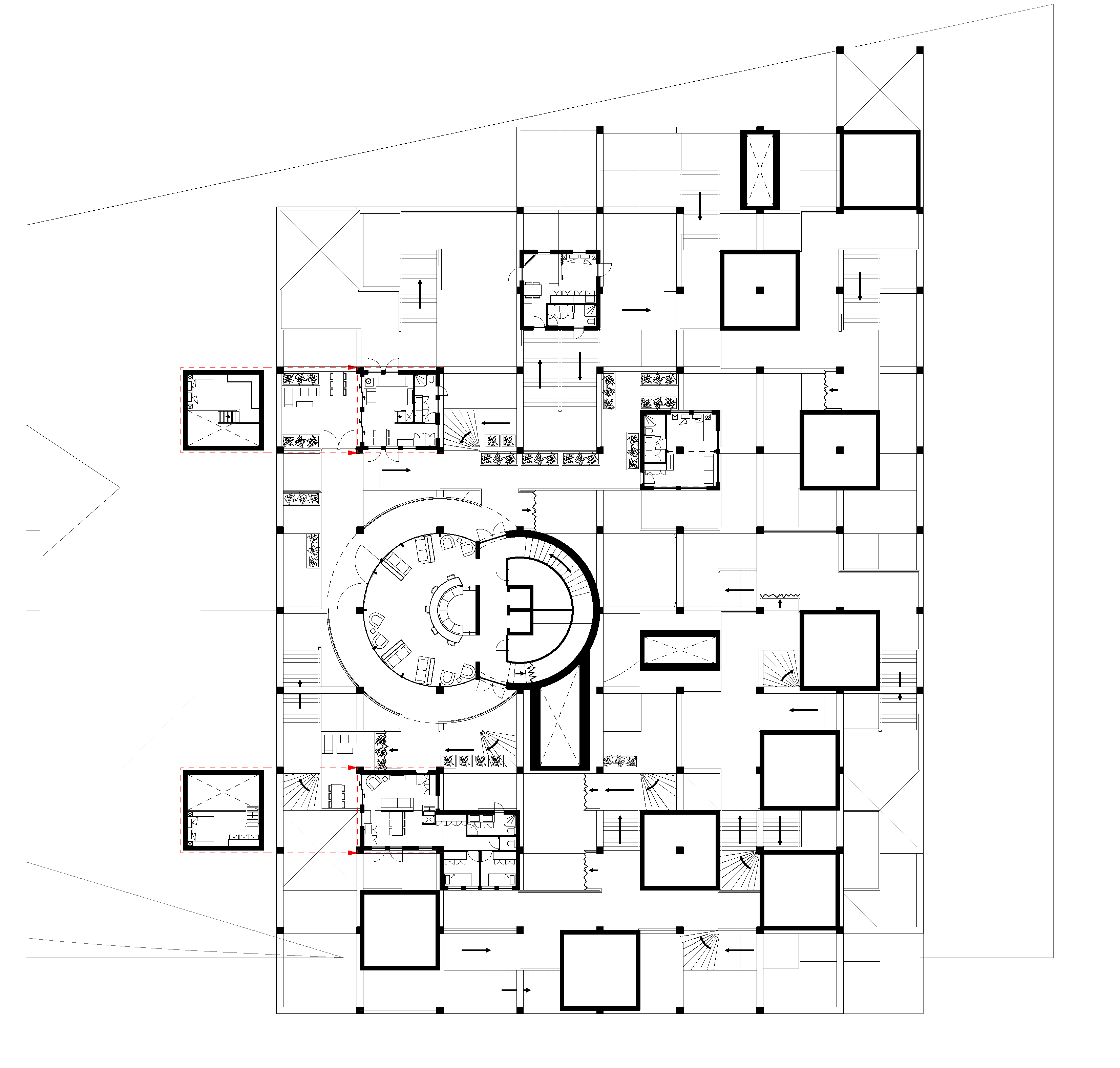
Floor plan for the fourth floor of the building

Floor plan for the fourth floor of the building
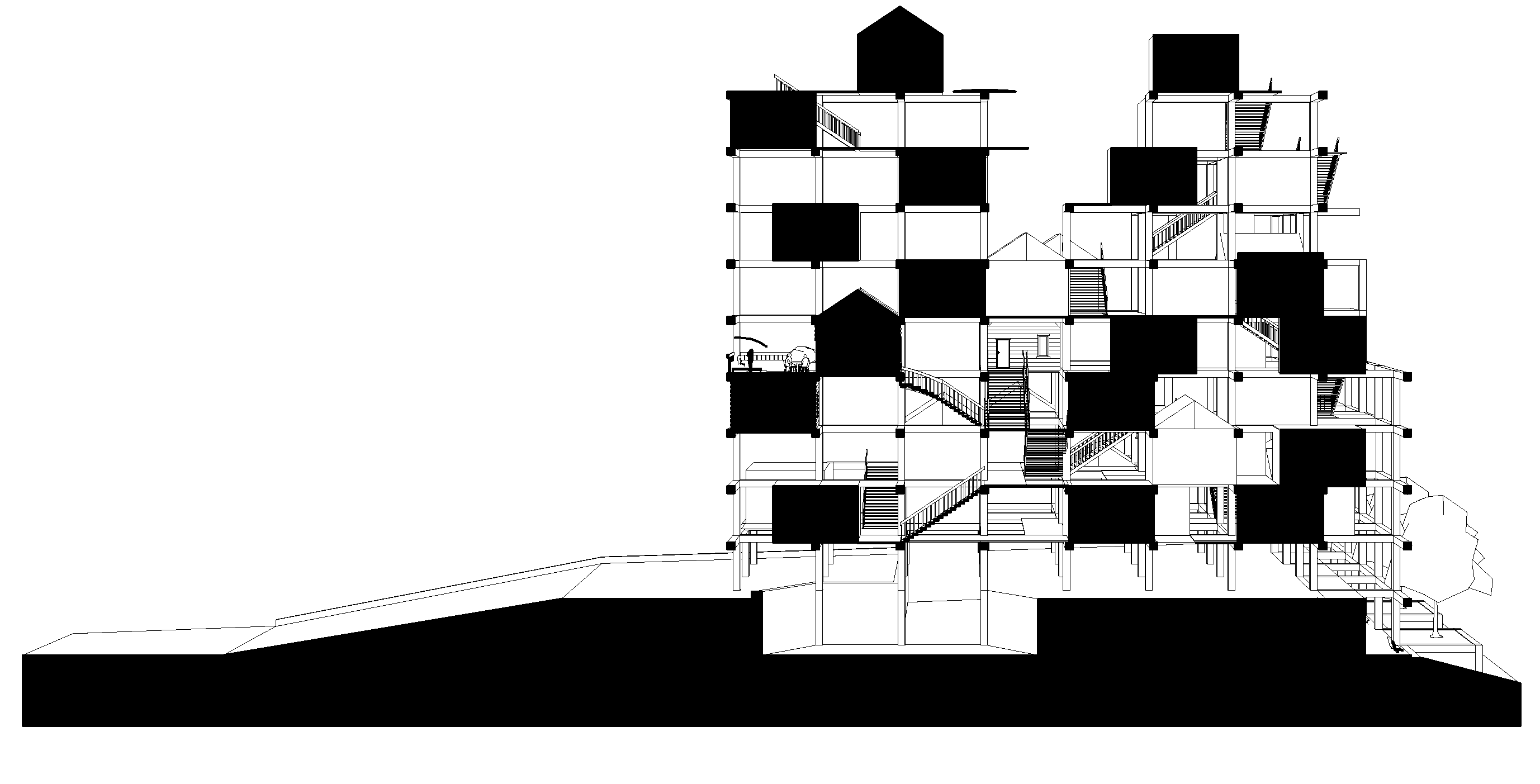
Section through the building, showing the use and arrangement of spaces

Section through the building, showing the use and arrangement of spaces
Composition
As shown in the diagram earlier, the main concept is that all the residences are individual units suspended around a central core, which houses most of the communal functions and facilities. All these spaces are connected through walkways and staircases to create a fun, lively and diverse array of spaces between them. The chaotic arrangement of volumes and connections allows for unique places to arise, creating a lively sense of adventure for residents when looking for a spot to meet and interact.
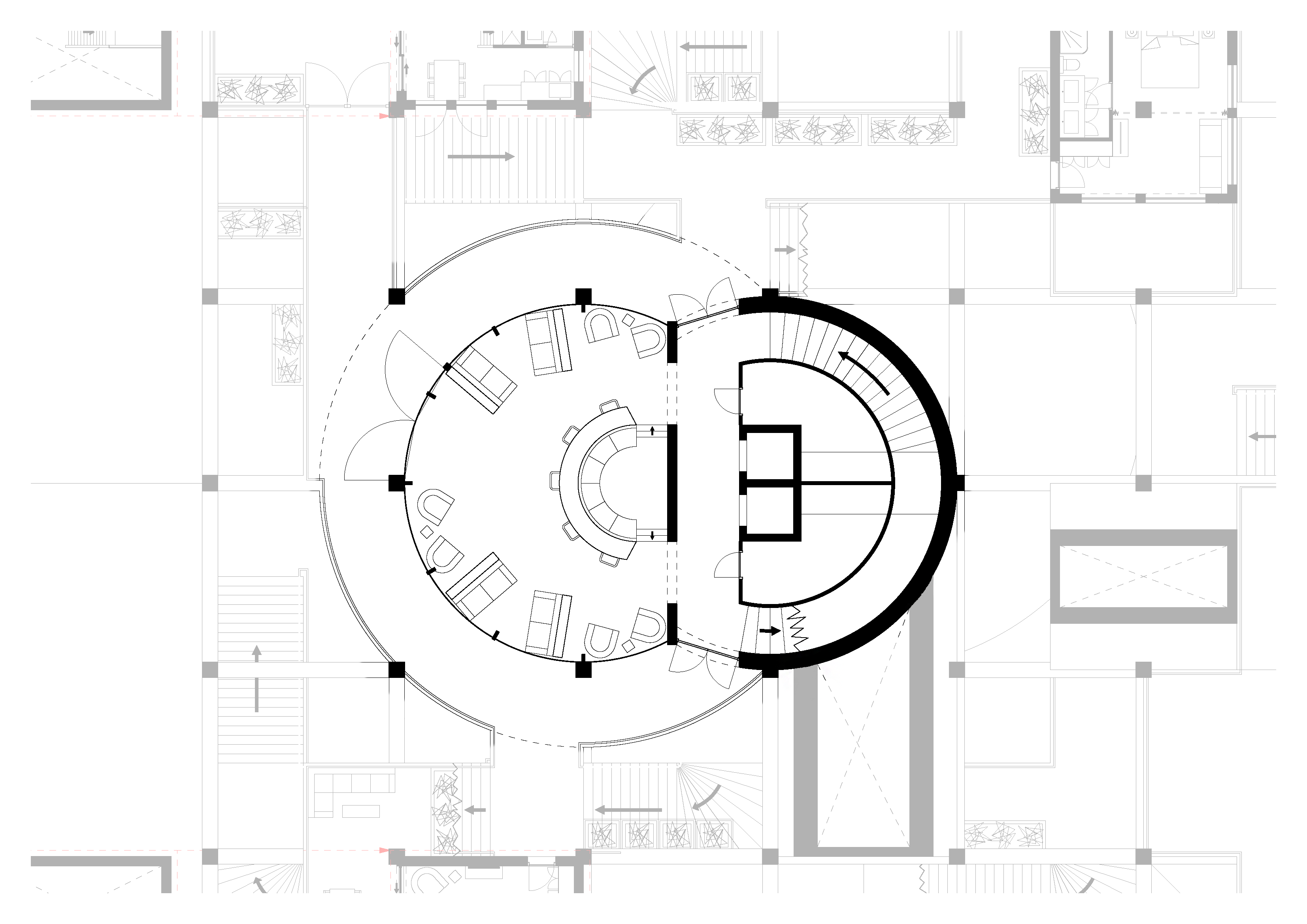
Plan for the communal living room located on the 4th floor

Plan for the communal living room located on the 4th floor
Communal Spaces
To encourage interaction between residents, and to foster a sense of community, the building features several communal spaces. If one's apartment begins to feel cramped or lonely, there are common living rooms, kitchens and gardens available to sit and work, relax and interact with neighbors. On the left,In the image above, one can see a plan for one such communal living room. It features a few nooks for quieter, more private interaction, as well as a central conversation pit, complete with a fire place. There are bookshelves and windows all around, providing excellent views and the ability to host an array of events in the space.
Apartments
The individual apartments are all self-standing units, characterized by standard variations of a 'base' unit. This, combined with their unique positioning within the greater whole, means that every apartment has its own experience. Some examples of apartments are shown below. In the first and second image, we see how the top apartment can make use of the apartment diagonally below it, by using its roof as a terrace. The second image also shows a 'base' unit, one block with no additions. Inside, we see that it has a bathroom, kitchenette, closet space, bed room and minimal living room. The smaller living room was chosen because it encourage more use of outdoor and communal areas, but still makes it possible to relax within one's own apartment. In the third image, we can see a double-sized unit with an adjacent terrace. Such apartments are generally targeted towards (larger) families who would require additional bedrooms.
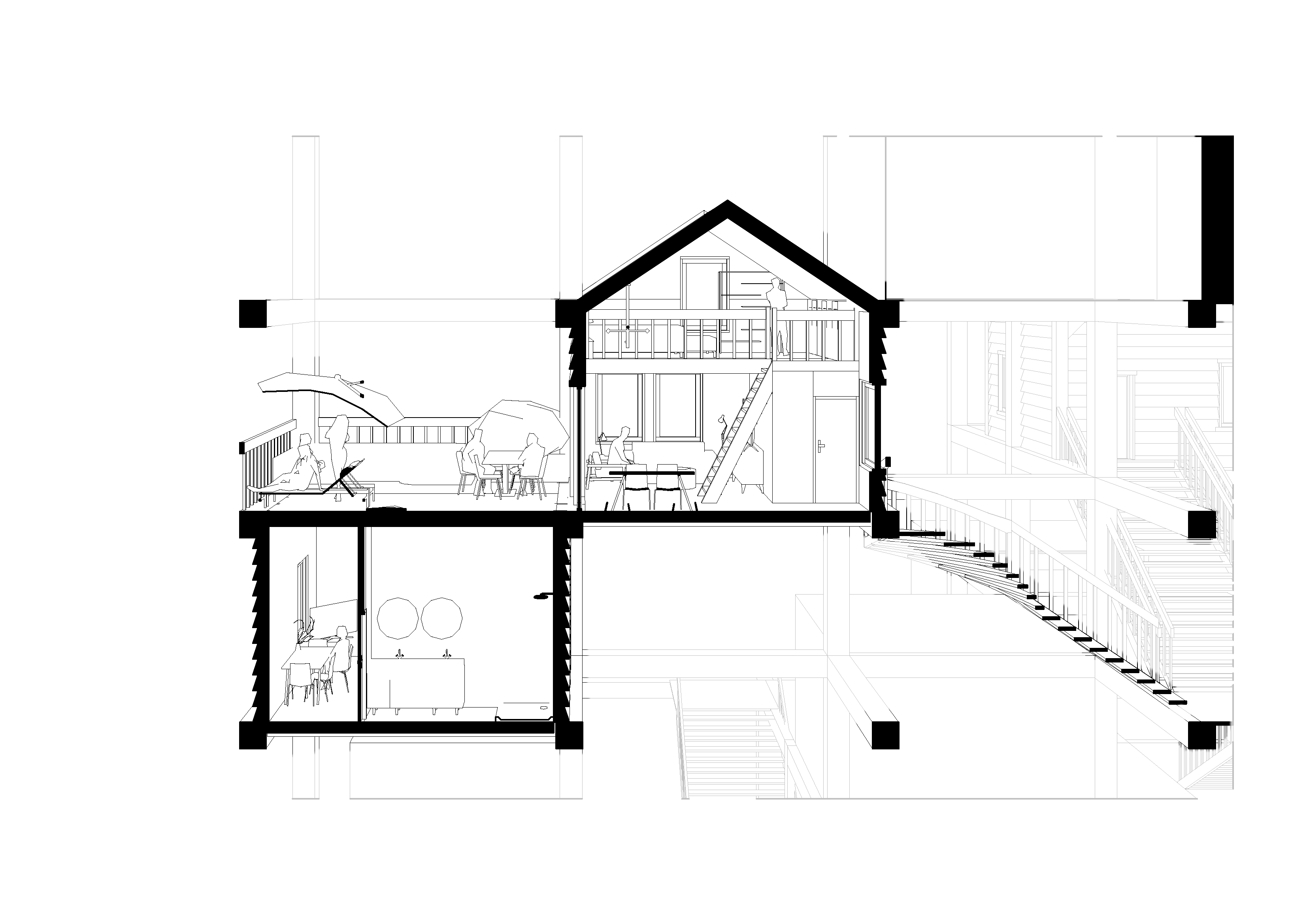
Section through two units, one of which uses the roof of the other as a terrace

Section through two units, one of which uses the roof of the other as a terrace
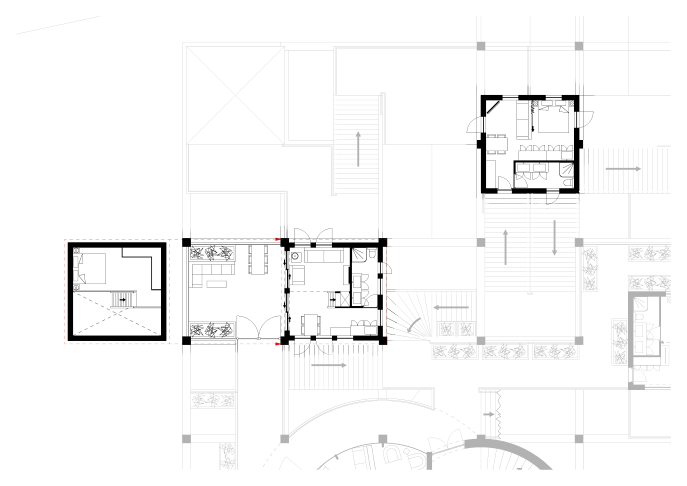
Plans for a unit with a full terrace adjacent, and a single unit with no additions

Plans for a unit with a full terrace adjacent, and a single unit with no additions
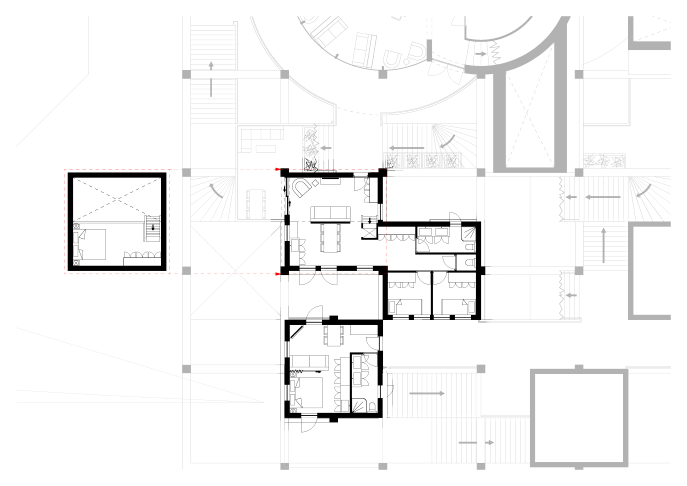
Plans for a double-sized unit and a single unit nearby

Plans for a double-sized unit and a single unit nearby
Project Renders
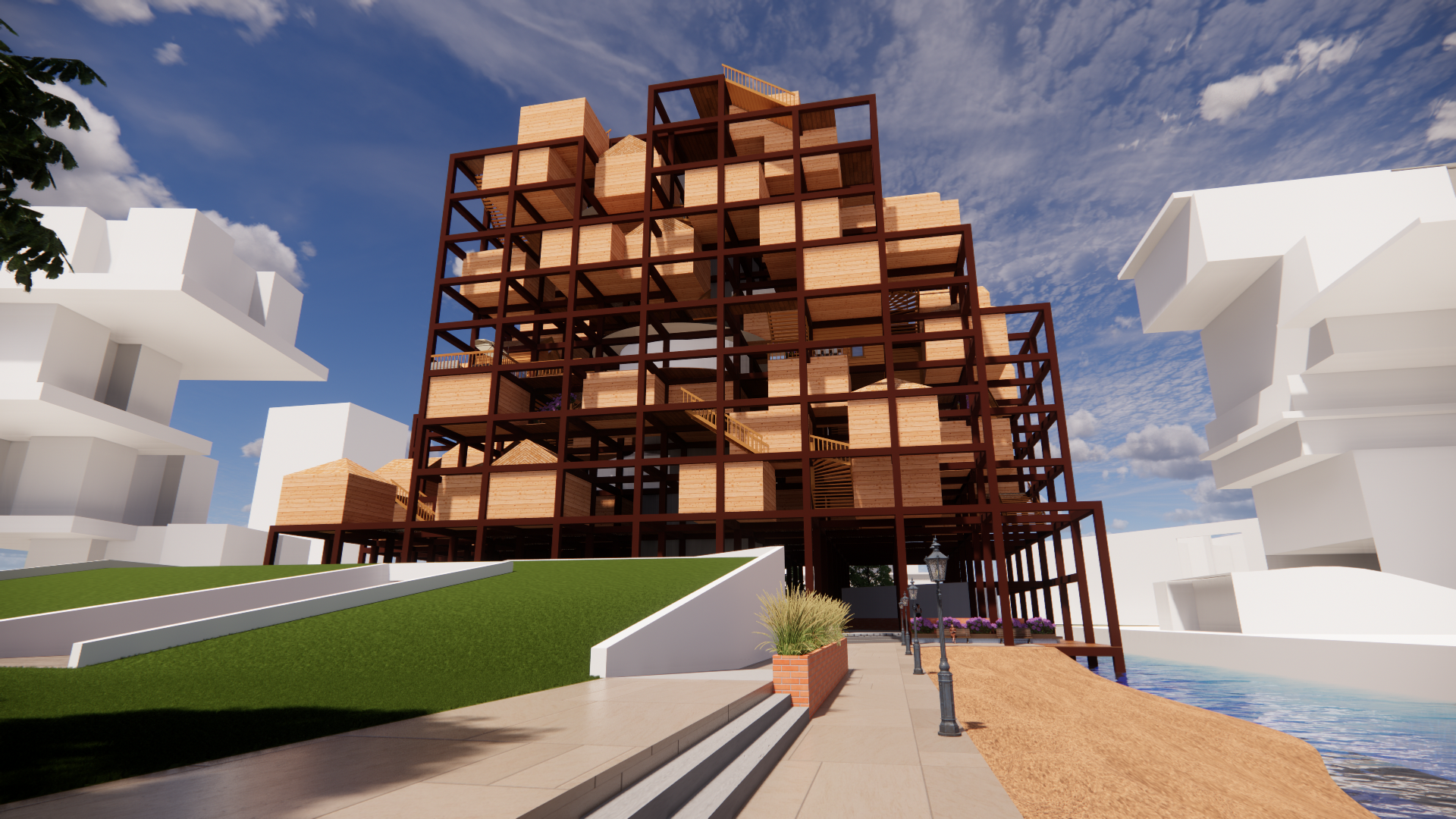
Beach next to building
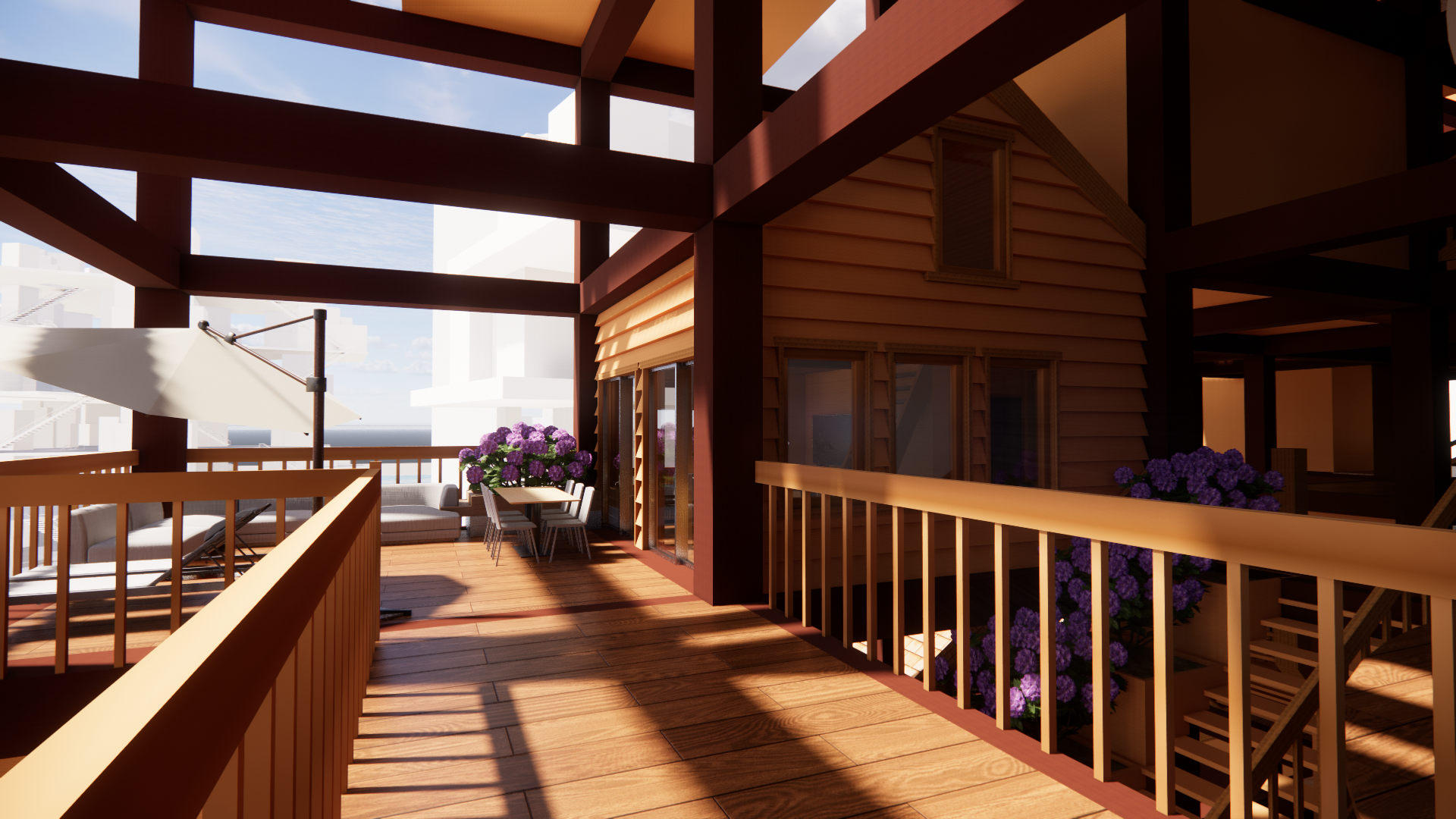
Transition public to private deck
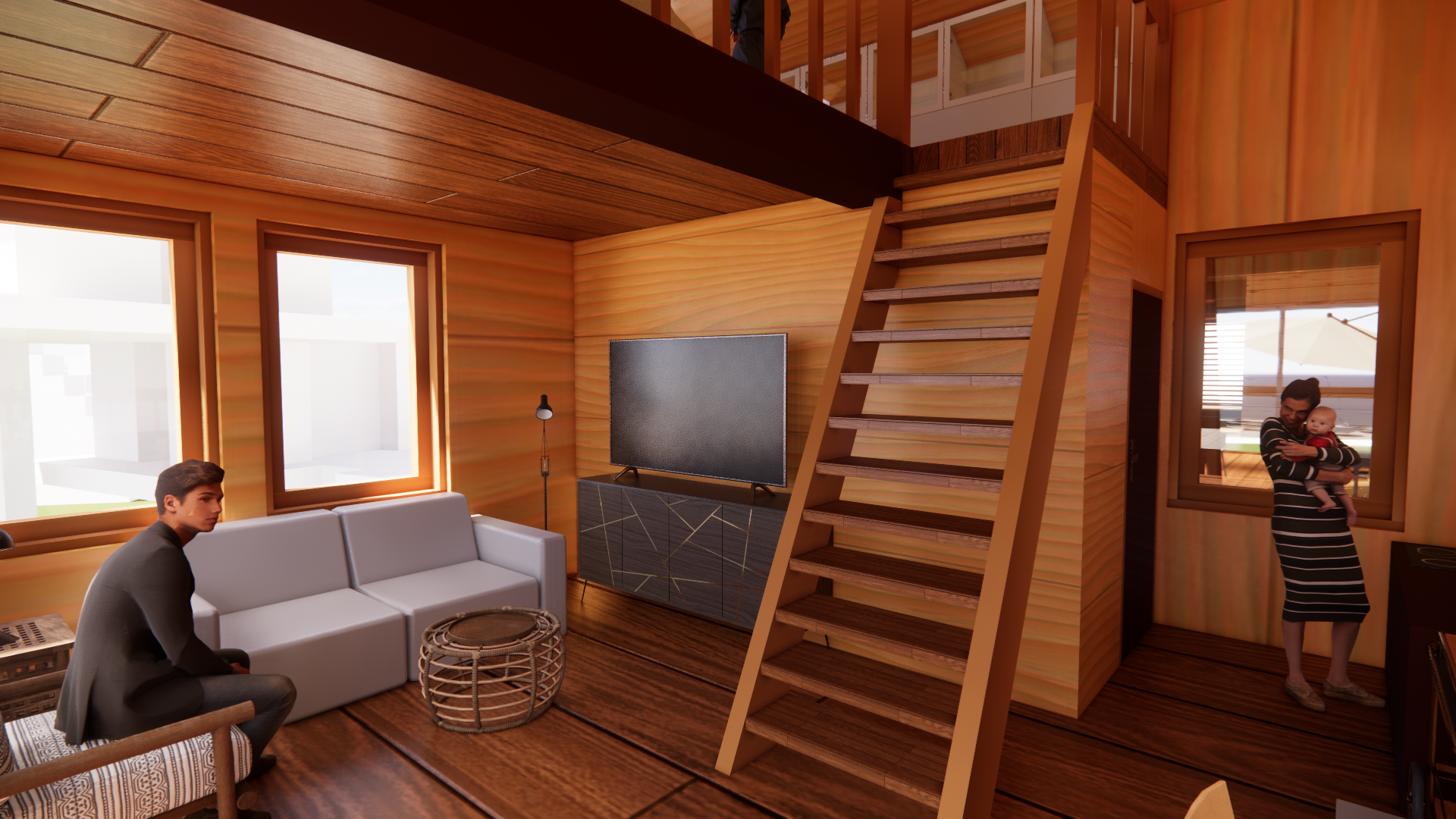
Example of a unit's interior
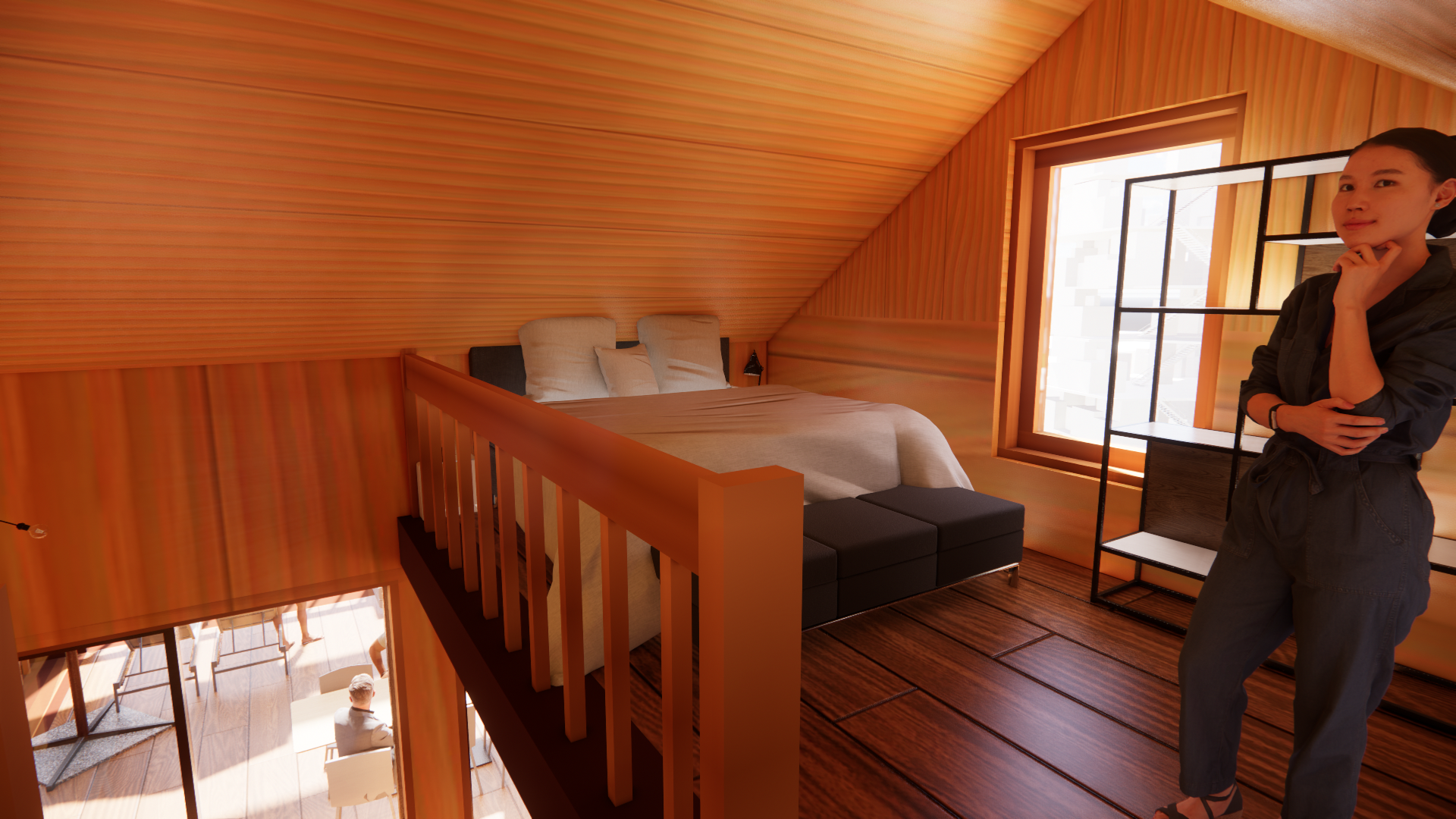
Example of a loft unit
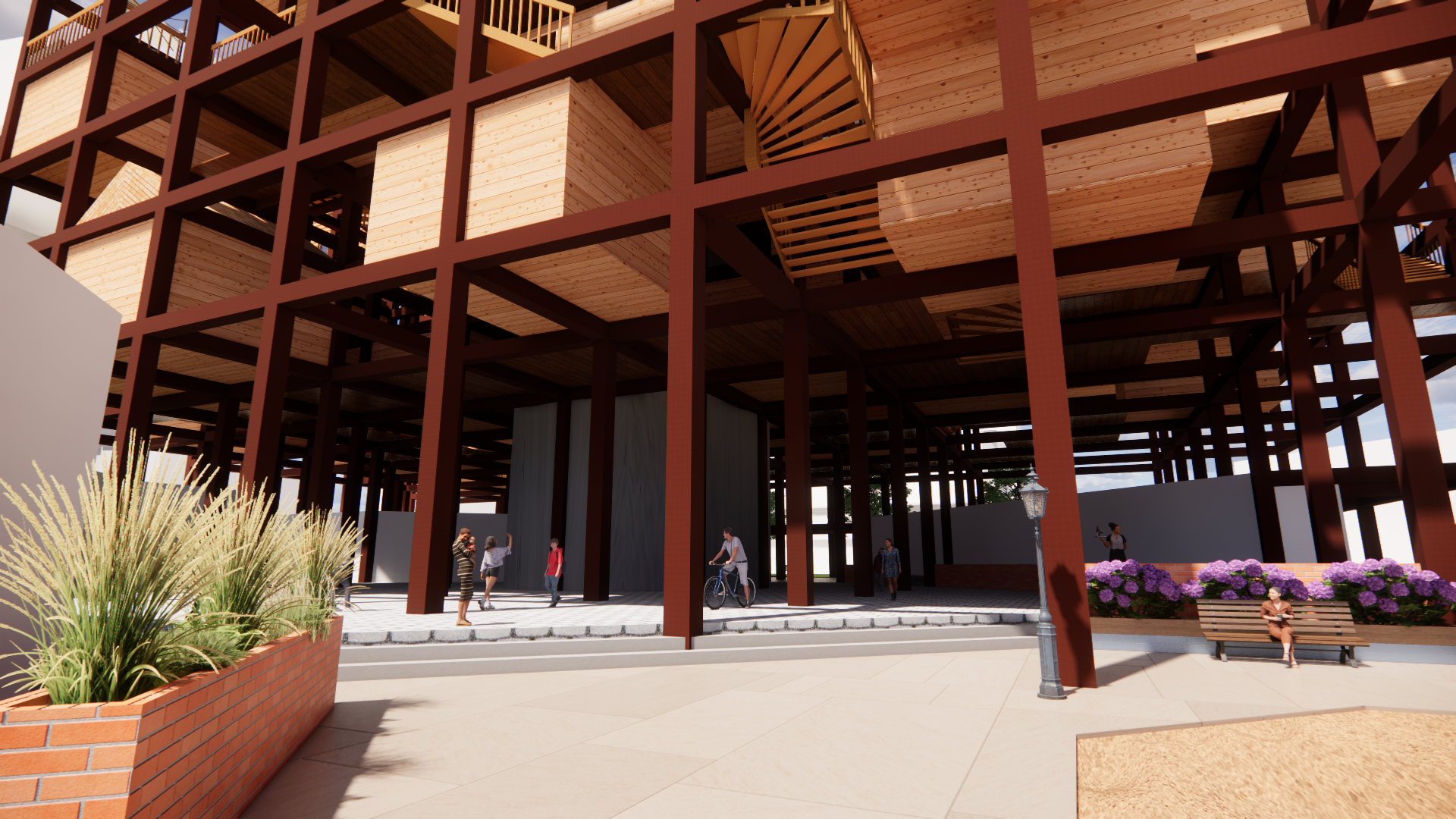
Shopping square under building
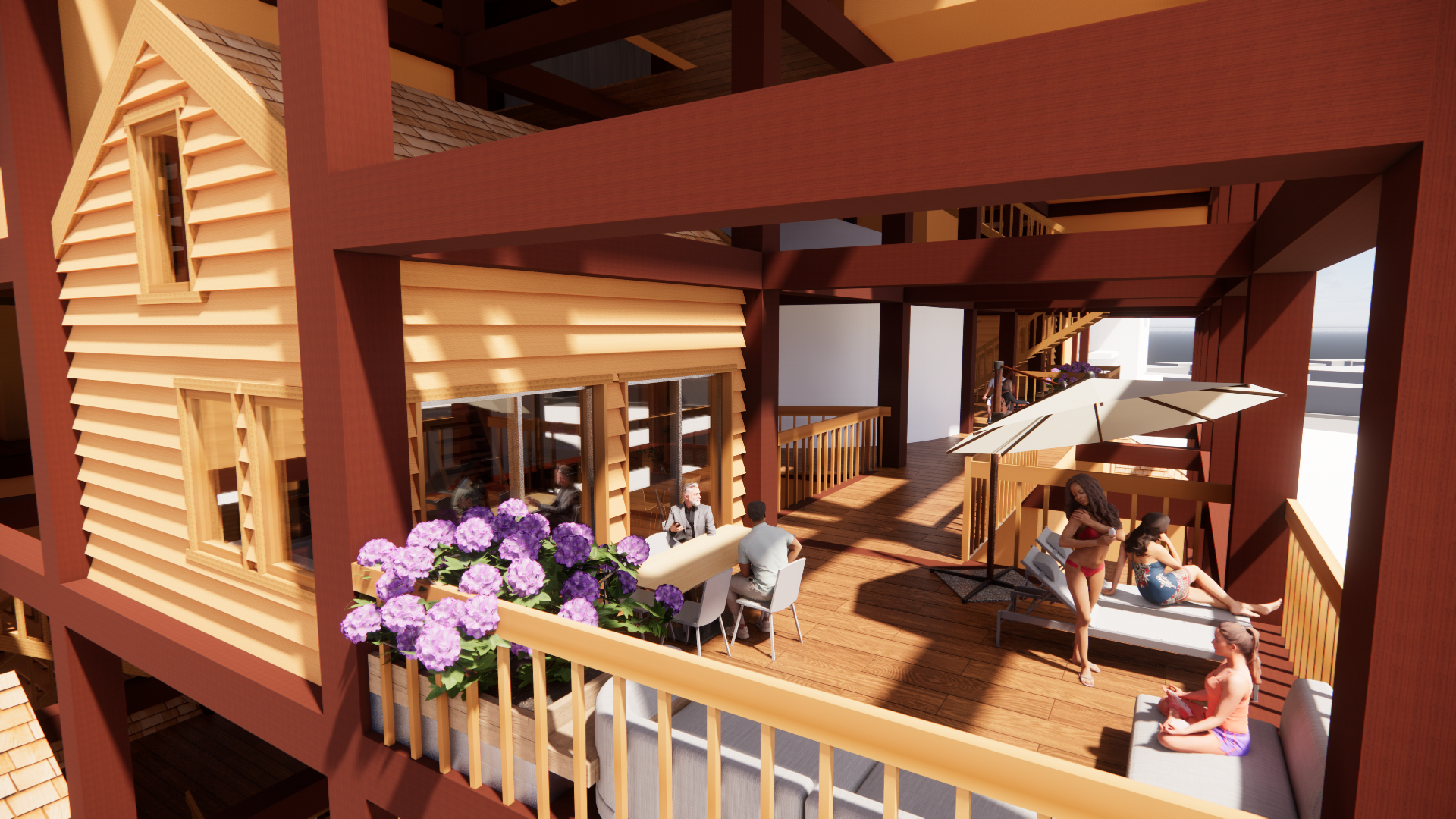
Example of a private terrace
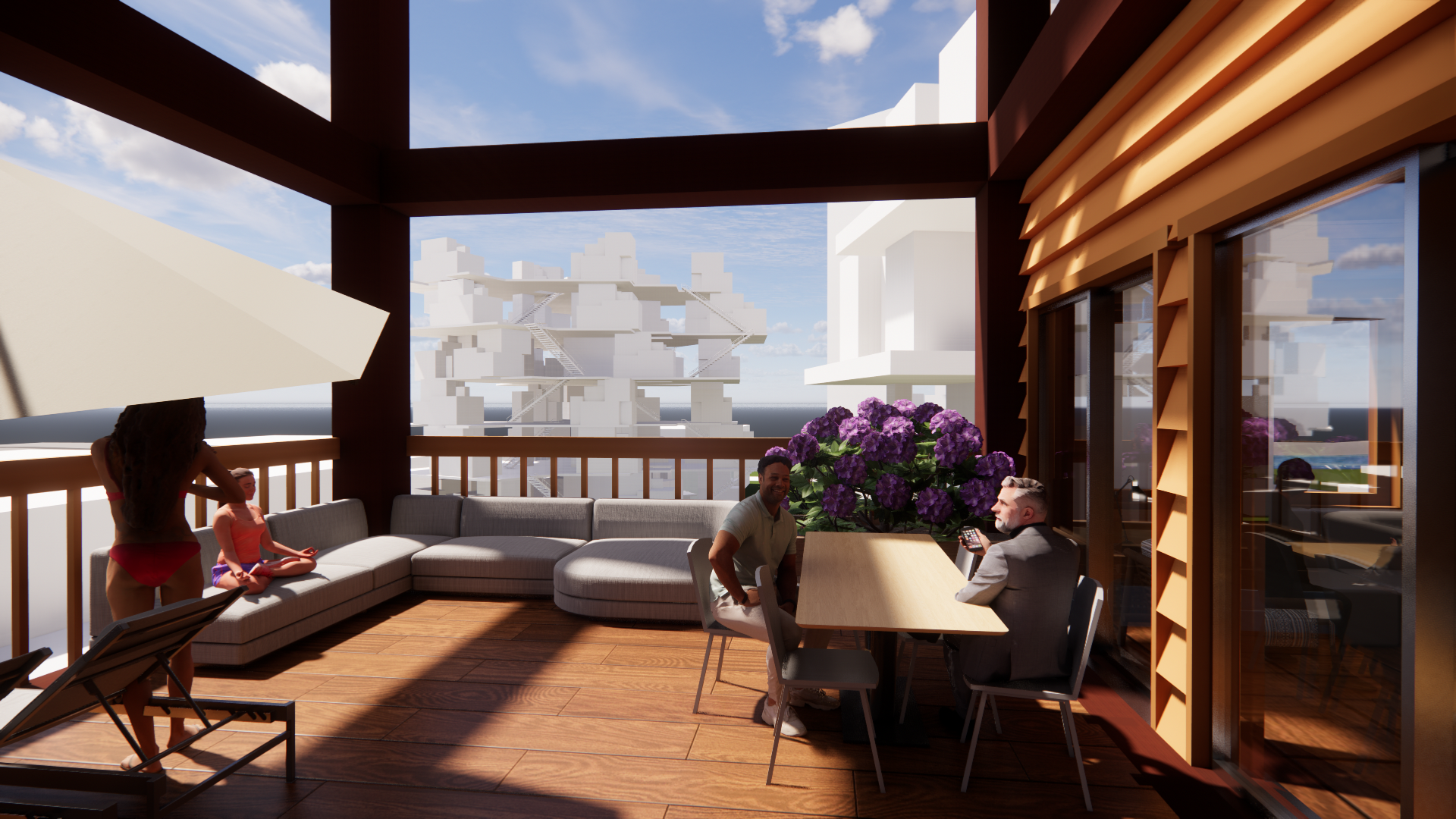
Example of a private terrace's view
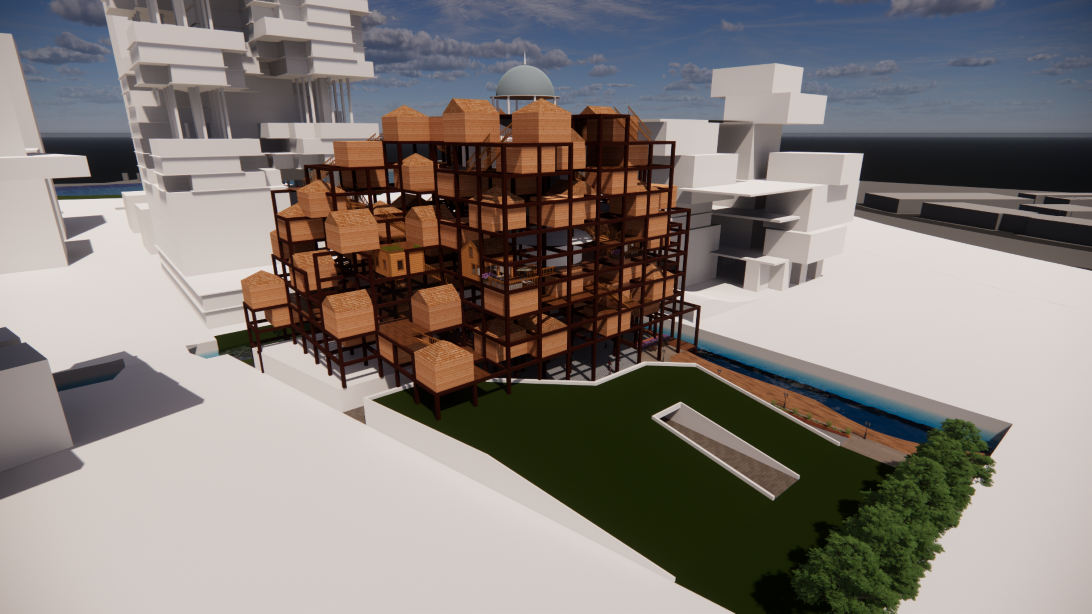
Bird's eye view of the building in the neighborhood
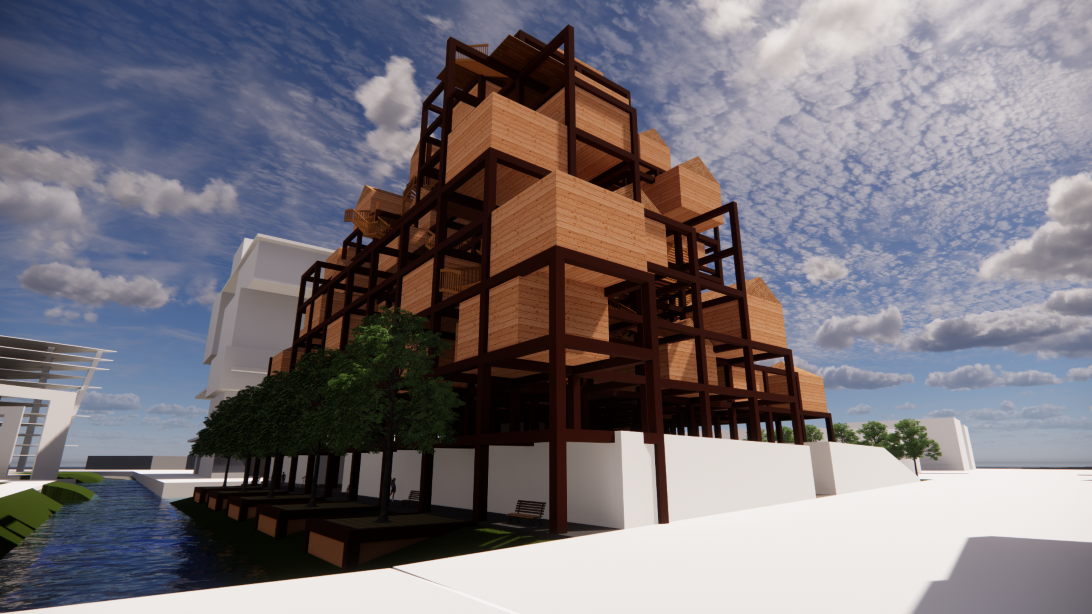
View from the Northwestern corner
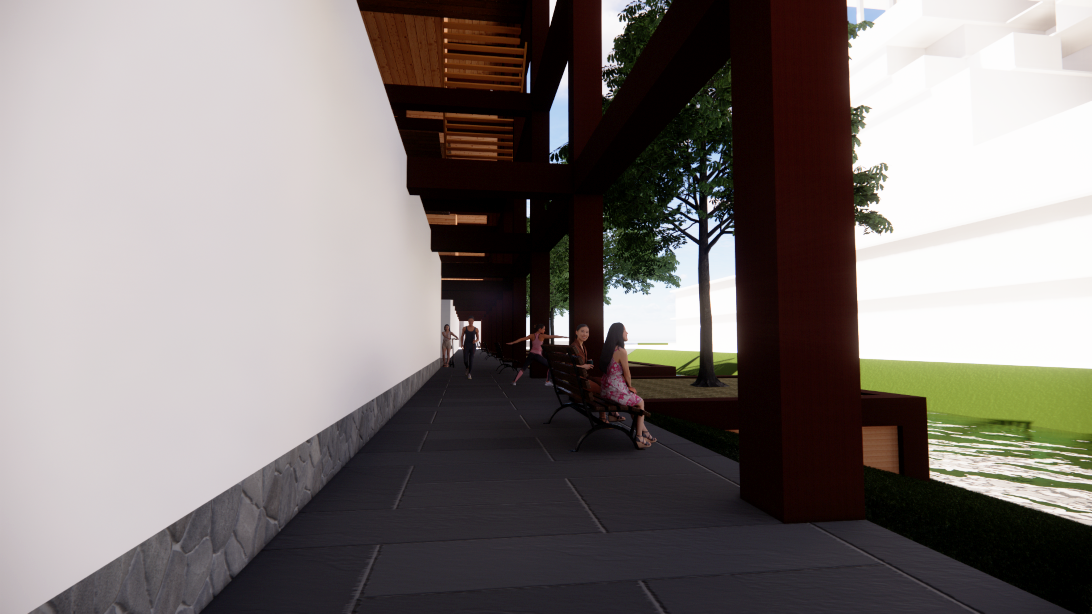
Recreational walk along the waterfront
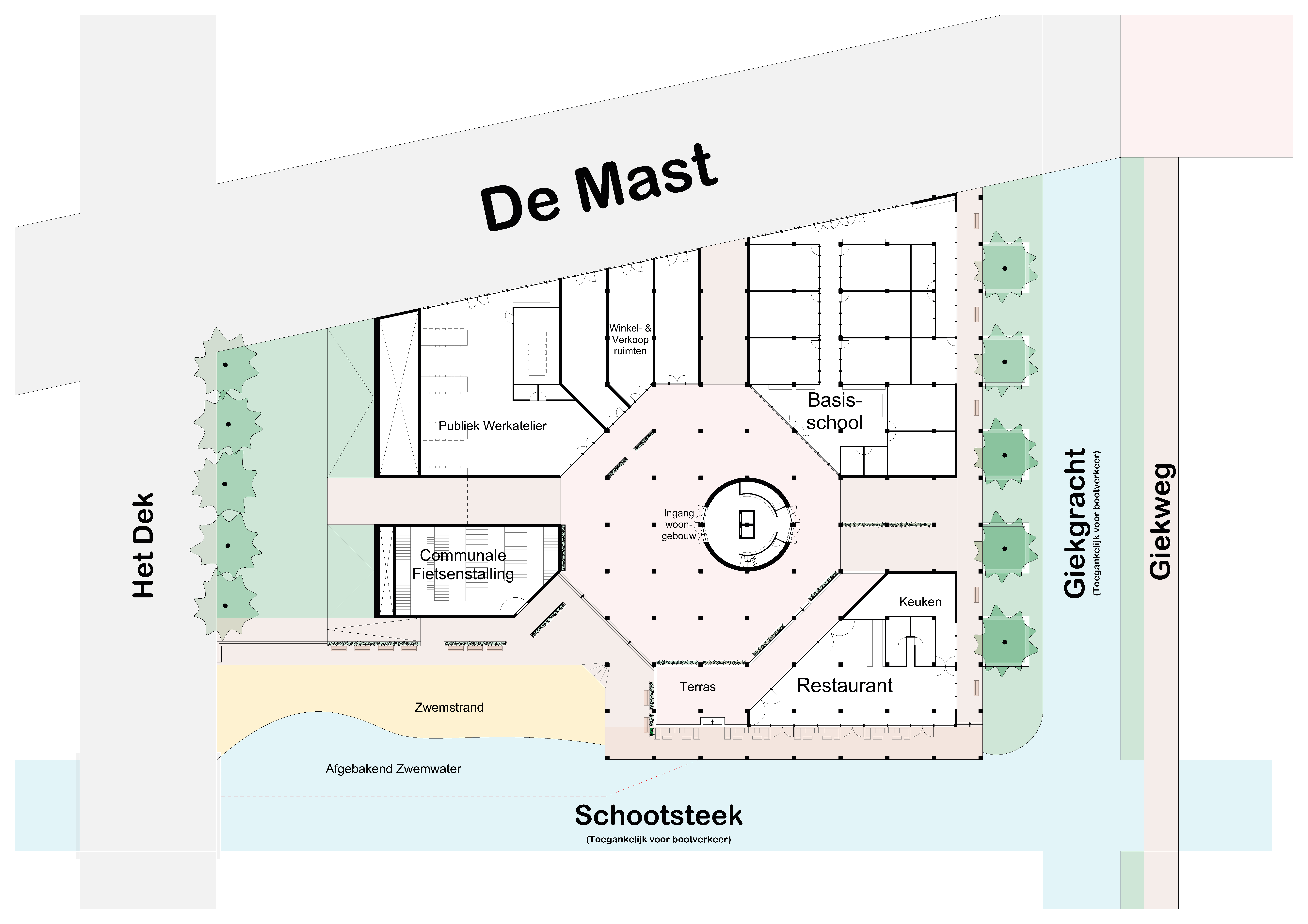
Plan showing the project at the ground level and how it relates to its surroundings

Plan showing the project at the ground level and how it relates to its surroundings
Relation to surroundings
One of the key aspects to the assignment was to collaborate with my fellow students to produce a cohesive and dynamic neighborhood. As such, my building, which is located on a relatively central plot would play a key part in that. As one of the few buildings targeted towards families and children, it made sense to house the neighborhood's primary school in the building. The ground level also features commercial space and a public workspace where people can come and concentrate if they lack a space to work properly from home. In addition, the plot is surrounded on two sides by water accessible to boats. The neighborhood, which is aimed to focus on leisure and interaction with the water (which is why all the streets and waterways are named after parts of a sailboat), it made sense to create walkways, greenery and terraces along the water. Along with a restaurant and a swimming beach, the building becomes a destination of its own right within the neighborhood, and creates more space for interaction between residents of the building and the neighborhood.
Other projects
Read more about related projects, or return to the project overview.
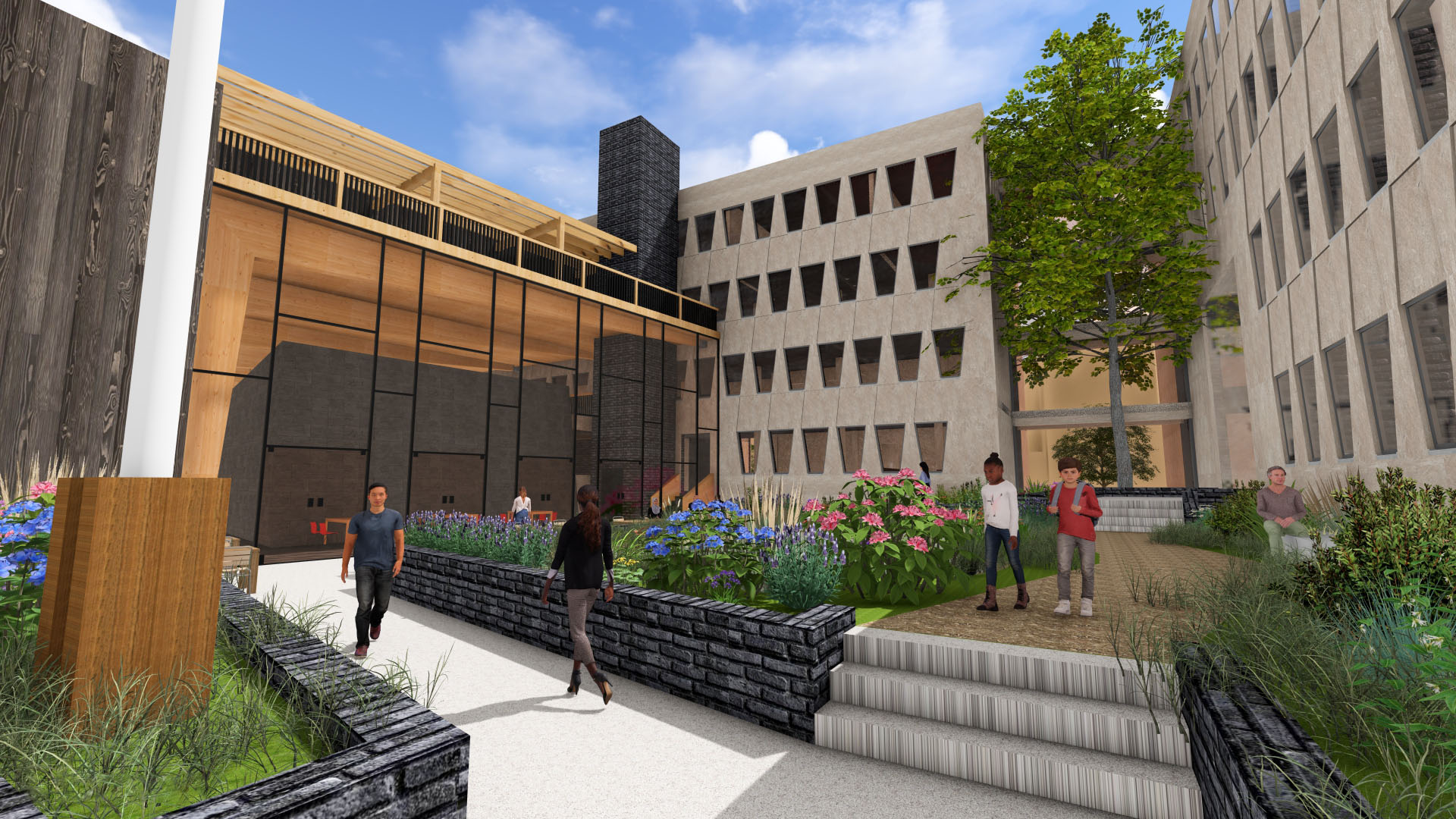
Most recent project
Tying Up Loose Ends >>
This redesign of the former United States Embassy to the Netherlands, located in the Hague, is all about blending existing values with new applications.

DuDock House >>
A passenger terminal for automated RoBoats. Includes a small museum for the concept, as well as the main RoBoat workshop and traffic control.
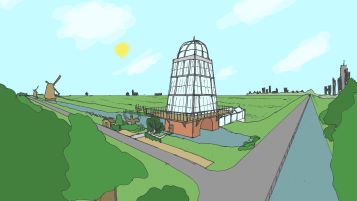
Very first project
Novo Molinus >>
A housing project for a park ranger, which also features a public learning and visitor's center, is an exemplary case of blending public and private life.
